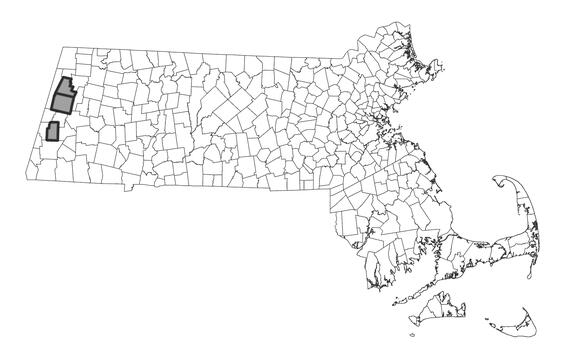- Scientific name: Myriophyllum verticillatum
- Species of Greatest Conservation Need (MA State Wildlife Action Plan)
- Endangered (MA Endangered Species Act)
Description
The whorled water-milfoil (Myriophyllum verticillatum) is an aquatic herb of the Haloragaceae family. The plant grows submersed in water, except for the terminal inflorescence, which emerges above the surface. Small, sessile flowers are oppositely arranged along the uppermost portion of the spike. The stems are elongate and narrow, often branched, and bear whorled leaves that are pinnately dissected into fine segments.
Distinguishing the various species of water-milfoils is difficult, especially in the vegetative condition, and a technical manual and an expert should always be consulted. This is one of a few water-milfoils that produce turions, which are small, bulb-like propagules that allow the plant to spread vegetatively. In this species, the turions are club-shaped (wider at the tips than at the base). Another diagnostic character is the presence of consistently deeply lobed floral bracts that greatly exceed (are more than twice as long as) the length of the female flowers. The combination of these characteristics, plus the presence of whorled leaves, serves to distinguish this species from the other water-milfoils in Massachusetts.
Common water-milfoils could easily be confused with the whorled water-milfoil. For example, the native lowly water-milfoil (Myriophyllum humile) differs in having leaves that are strictly alternate, rather than whorled as in the whorled water-milfoil. The lowly water-milfoil is also more typically found in less alkaline waters than the whorled water-milfoil. In addition, the two invasive, non-native species of water-milfoil could be confused with this species. Both of these species also have whorled leaves. However, the Eurasian water-milfoil (Myriophyllum spicatum) usually has whorls of leaves that are more widely spaced along the stem, has truncate (straight, as if cut off) uppermost leaf tips, has floral bracts that are less than twice as long as the female flowers, and does not produce winter buds. The variable water-milfoil (Myriophyllum heterophyllum) has long bracts beneath the female flowers, like the whorled water-milfoil; however, these bracts are not consistently deeply lobed, having some bracts that are merely toothed. The stem of the variable water-milfoil is often red, unlike the more olive color of the stems of the whorled water-milfoil.
Population status
The whorled water-milfoil is listed as endangered by the Commonwealth because it is known from only three locations in Massachusetts, all in Berkshire County. As with all species listed in Massachusetts, individuals of the species are protected from take (picking, collecting, killing) or sale under the Massachusetts Endangered Species Act. The Massachusetts Natural Heritage & Endangered Species Program has 4 records from 2 counties: Berkshire and Franklin. Three of these records have been observed within the last 25 years.

Distribution in Massachusetts. 1999-2024. Based on records in the Natural Heritage Database.
Distribution and abundance
The whorled water-milfoil is circumboreal and occurs south to Maryland and west to Texas and California.
Habitat
In Massachusetts, the whorled water-milfoil is found in shallow, still waters of alkaline lakes and ponds. It is often found growing in association with other rare aquatic species, such as the endangered straight-leaved pondweed (Potamogeton strictifolius), and the globally rare and state-endangered Ogden’s pondweed (Potamogeton ogdenii). It is also found with generally uncommon species that are adapted to alkaline waters, such as water star-grass (Heteranthera dubia) and water-marigold (Megalodonta beckii).
Healthy habitats are vital for supporting native wildlife and plants. Explore habitats and learn about conservation and restoration in Massachusetts.
Threats
Competition with invasive exotic aquatic species such as the Eurasian water-milfoil (Myriophyllum spicatum) is a potential threat to populations of the whorled water-milfoil. Ironically, broad-scale herbicide application, weed raking, or draw-downs to control invasive aquatic plants may also threaten this rare species. Any drastic alteration in the habitat of the whorled water-milfoil, including pond-bottom dredging, water drawdown, changes to the rate of water flow, or indiscriminate weed control, could threaten the survival of populations of the whorled water-milfoil.
Conservation
The exact needs for the management of the whorled water-milfoil are not precisely known. Hand-pulling of aquatic invasive species is recommended around populations of rare aquatic species.
Contact
| Date published: | May 9, 2025 |
|---|